|
|
|
Sort Order |
|
|
|
Items / Page
|
|
|
|
|
|
|
| Srl | Item |
| 1 |
ID:
103651
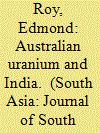

|
|
|
|
|
| Publication |
2011.
|
| Summary/Abstract |
This article is a study of the Australian government's policy of not selling uranium to India. Successive Australian governments have used the Nuclear Non-Proliferation Treaty (NPT) to refuse India's repeated requests for uranium. This study looks at the Indian response to this policy and asks how long Australia can sustain its stand in the face of climate change, economic growth and growing bilateral relations between two democracies with shared interests.
|
|
|
|
|
|
|
|
|
|
|
|
|
|
|
|
| 2 |
ID:
140841
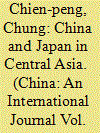

|
|
|
|
|
| Summary/Abstract |
Central Asia is a region where both China and Japan would like to pursue greater roles and interests. Largely initiated by China, the Shanghai Cooperation Organisation has enhanced China’s influence in Central Asia. This has caused concern for Japan, which then sought to expand its presence in the region. Through meetings and dialogues with Central Asian leaders, and by providing aid and loans to states in the region, leaders of China and Japan have been trying to obtain contracts for extracting oil, natural gas, rare metals, uranium and other minerals from Central Asian states, and secure peace in Afghanistan.
|
|
|
|
|
|
|
|
|
|
|
|
|
|
|
|
| 3 |
ID:
088245
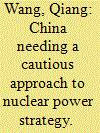

|
|
|
|
|
| Publication |
2009.
|
| Summary/Abstract |
China is leading the recent revival of nuclear energy programs. The Chinese government plans to increase nuclear generating capacity to 40 GWe by 2020, while the installed capacity is 8.6 GWe in 2007. In view of the enthusiasm shown for nuclear electricity throughout the country, the actual scale of Chinese nuclear power development is expected to reach 70 GWe by 2020. However, the low cost proven uranium reverses (cost category to <130 US $/kg) in China only meet half demand of 40 GWe capacity in 2020. And overlying China's increased demand is continued political sensitivity about the uranium trade. Meanwhile, the capacity of China's spent fuel reprocessing cannot keep up with the increasing spent fuel. And the legal administrative system of radioactive waste and spent fuel management is outdated. Hence it is proposed in this paper that the accelerated development of nuclear power industry is not good, and the over-accelerated development may be harmful, without appropriately considering the uranium resources and spent fuel management.
|
|
|
|
|
|
|
|
|
|
|
|
|
|
|
|
| 4 |
ID:
104158
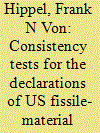

|
|
|
|
|
| Publication |
2011.
|
| Summary/Abstract |
In the 1970s and early 1980s, the United States Government released data on the history of its purchases of natural uranium, the amount of separative work done by U.S. uranium enrichment plants, and the fission energy released by U.S. production reactors. These data provided the basis of nongovernmental estimates in the 1980s of U.S. production of plutonium and highly enriched uranium. In 1996 and 2006, the United States published reports on its historical production of plutonium and highly enriched uranium respectively. This article presents a first rough analysis of the two sets of data and finds that they are reasonably consistent.
|
|
|
|
|
|
|
|
|
|
|
|
|
|
|
|
| 5 |
ID:
101263
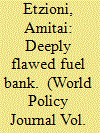

|
|
|
| 6 |
ID:
100137
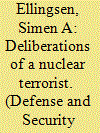

|
|
|
| 7 |
ID:
072884
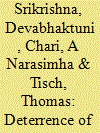

|
|
|
|
|
| Publication |
2005.
|
| Summary/Abstract |
The United States has multiple nuclear detection initiatives to secure against a terrorist nuclear attack, including the Container Security Initiative, installation of radiation detectors at U.S. border points of entry, and establishment of the Domestic Nuclear Detection Office (DNDO). The current nuclear detection system architecture falls short of being able to reliably catch fissile nuclear material in transit, specifically shielded Highly Enriched Uranium (HEU) and Plutonium (Pu), both within the US and abroad. Checkpoints at border crossings can be circumvented, and no adequate system is under development to deter the transport of fissile materials. Using nuclear link-budget calculations, we show why a network relying primarily on handhelds, fixed detectors, and portals is not sufficient. We examine the technical, economic, and operational feasibility of a comprehensive national network incorporating in-vehicle detectors to reliably detect and deter the transport of fissile material inside the vehicle itself.
|
|
|
|
|
|
|
|
|
|
|
|
|
|
|
|
| 8 |
ID:
126444
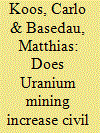

|
|
|
|
|
| Publication |
2013.
|
| Summary/Abstract |
We investigate whether uranium, similar to other resources, is associated with armed conflicts. The analysis uses grid cells in Africa to test this hypothesis. Results from logistic regressions reveal that uranium operations are not an independent conflict risk; however, it is significantly linked to local conflict events when interacting with ethnic exclusion. The analysis is supplemented by process tracing in four countries, where armed conflict broke out after uranium operations started (DR Congo, Central African Republic, Niger and South Africa). We find substantial evidence for a link only in the case of Niger. Our results suggest that uranium promotes intrastate conflict only under specific circumstances.
|
|
|
|
|
|
|
|
|
|
|
|
|
|
|
|
| 9 |
ID:
076774
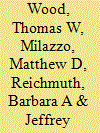

|
|
|
|
|
| Publication |
2007.
|
| Summary/Abstract |
Iran has pursued an ambitious nuclear program with the declared goal of long-term energy independence. While this is a worthwhile and generally accepted national planning objective, it is clear that Iran's nuclear program as now structured will not achieve this goal, and in fact may delay it by diverting capital and other resources from projects that would address pressing current energy sector problems and contribute to ultimate energy independence for Iran.
|
|
|
|
|
|
|
|
|
|
|
|
|
|
|
|
| 10 |
ID:
084022
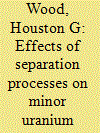

|
|
|
|
|
| Publication |
2008.
|
| Summary/Abstract |
In natural uranium, there are trace amounts of the "minor isotope" 234U in addition to the more abundant 235U and 238U. Uranium irradiated in a reactor and separated from the spent reactor fuel by reprocessing will contain additional minor isotopes. In uranium enrichment, cascades of separating units are tuned to produce the desired level of the isotope 235U, but the levels of other isotopes will also change. Measurement of the assays of the 235U in the feed, product and withdrawal streams of each stage allow the calculation of the stage separation factor for the 235U. The separation factors for the other isotopes may be calculated. In this aritcle, two methods of modeling the separation factors in a way that represents the physics of two enrichment processes, gas centrifuge and gaseous diffusion, are explored. This technique could be a valuable tool in nuclear forensics. For example, it could be important to know the origin of a sample of highly enriched uranium, found either in intercepted material or in explosive debris. Analysis that could point to the enrichment plant where the uranium was produced could immediately identify weaknesses in safeguards and physical security systems.
|
|
|
|
|
|
|
|
|
|
|
|
|
|
|
|
| 11 |
ID:
109108
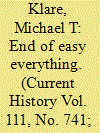

|
|
|
| 12 |
ID:
092913
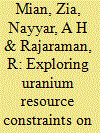

|
|
|
|
|
| Publication |
2009.
|
| Summary/Abstract |
This paper evaluates possible scenarios for Pakistan's uranium enrichment and plutonium production programs since the late 1970s by using Pakistan's supply of natural uranium as a constraint. Since international sanctions have prevented Pakistan from importing uranium for decades, it has had to rely on domestic uranium production-currently estimated as approximately 40 tons a year. The paper divides the development of Pakistan's uranium enrichment and plutonium production programs into three broad periods: from the beginning in the late 1970s until the 1998 nuclear tests; from 1999 to the present; and from the present to 2020; and considers how Pakistan could allocate its domestic uranium between its uranium enrichment and plutonium production programs for each period. This assessment is completed for enrichment capacities ranging from 15,000 to 75,000 separative work units (SWU) and takes into account the construction of the second and third plutonium production reactors at Khushab. The study finds that Pakistan may have sufficient natural uranium to fuel the three reactors, if they are approximately 50 MWt each, but that for some of these enrichment capacities, there will be a shortfall of natural uranium by 2020. The paper considers the impact of alternative sources of enrichment feed such as depleted tails from previous enrichment activity and reprocessed uranium from low-burn-up spent fuel from the Khushab reactors. There are signs Pakistan early on may have enriched some reprocessed uranium, possibly acquired from China. It finds that by 2020, Pakistan could have accumulated approximately 450 kg of plutonium from the Khushab reactors and 2500-6000 kg of highly enriched uranium (HEU) (90 percent enriched) for enrichment capacities ranging from 15,000-75,000 SWU. These stocks would be sufficient for perhaps 100-240 simple fission weapons based on HEU and for 90 plutonium weapons. Pakistan may be able to produce more weapons if it either increases its rate of uranium mining or has more advanced weapon designs requiring less fissile material in each weapon.
|
|
|
|
|
|
|
|
|
|
|
|
|
|
|
|
| 13 |
ID:
085059
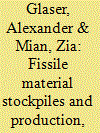

|
|
|
|
|
| Publication |
2008.
|
| Summary/Abstract |
This article presents estimates of global and national stockpiles of highly enriched uranium and separated plutonium based on the 2008 Global Fissile Material Report by the International Panel on Fissile Materials.1 The global stockpile of highly enriched uranium (HEU) is estimated to be 1670 ± 300 tons. It is declining as Russia and the United States blend down about 40 tons per year of HEU for use in light-water power-reactor fuel. This rate of blend-down is far higher than the estimated rate of production of HEU, currently believed to be limited to production by Pakistan for weapons and by India for naval fuel. The global stockpile of separated plutonium, all of which can be used for weapons, is about 500 tons. About half of this stockpile is civilian and is currently growing at less than 5 tons a year. This rate will increase significantly once Japan's Rokkasho reprocessing plant begins commercial operation. Only India and Pakistan and perhaps Israel are believed to be producing plutonium for weapons, at a combined rate of less than 60 kg per year. The United States and Russia have declared as excess to weapons requirements or for all military purposes a significant fraction of their stocks of both highly enriched uranium and plutonium produced for weapons. The United States and Russia continue to blend down the 210 and 500 tons, respectively, of HEU that they have declared excess to produce low-enriched uranium to fuel light-water reactors. The United States and Russia have yet to put in place the infrastructure to eliminate the 34 tons of excess weapons plutonium each committed to dispose under the 2000 U.S.-Russian Plutonium Management and Disposition Agreement. The past two years have also seen plans for new civilian enrichment plants and progress on new reprocessing plants. During this time, some former production facilities have been shut down, others dismantled, and in some cases key components have been demolished.
|
|
|
|
|
|
|
|
|
|
|
|
|
|
|
|
| 14 |
ID:
048266
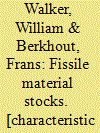

|
|
|
|
|
| Publication |
New York, United Nations, 1999.
|
| Description |
x, 60p.
|
| Series |
UNIDIR/99/8
|
| Standard Number |
9290451319
|
|
|
|
|
|
|
|
|
|
|
|
Copies: C:2/I:0,R:0,Q:0
Circulation
| Accession# | Call# | Current Location | Status | Policy | Location |
| 041383 | 355.825119/WAL 041383 | Main | On Shelf | General | |
| 041973 | 355.825119/WAL 041973 | Main | On Shelf | General | |
|
|
|
|
| 15 |
ID:
123987
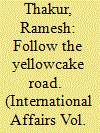

|
|
|
|
|
| Publication |
2013.
|
| Summary/Abstract |
The question of whether Australia should change government policy to permit the export of uranium to India has divided Australians, arms control advocates and scholars. This article does not take a position for or against Australia's export of uranium to India. Instead, it argues that the concept of 'the national interest' is misleading as the analytical framework for assessing this important foreign policy decision, and leads to a distorted analysis and policy prescription.
It is not all that difficult for the government to justify a decision to sell uranium to India as being in the national interest. But a more nuanced and complicated analysis results when the issue is discussed using a novel analytical framework of 'a balance of interests'. 'The national interest' is erroneous as a description of the empirical reality, substitutes tautology for explanation and is unhelpful as a guide to policy.
'A balance of interests' is superior on all three counts of description, explanation and prescription. In addition, it captures human agency and allows for human error and multiple balances as weighed by different people reflecting their personal predilections, professional backgrounds, life and career experiences, party philosophy, and institutional interests and perspectives.
|
|
|
|
|
|
|
|
|
|
|
|
|
|
|
|
| 16 |
ID:
068702
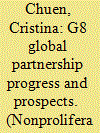

|
|
|
| 17 |
ID:
104161
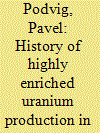

|
|
|
| 18 |
ID:
133092
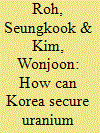

|
|
|
|
|
| Publication |
2014.
|
| Summary/Abstract |
South Korea is heavily dependent on energy resources from other countries and nuclear energy accounts for 31% of Korea's electric power generation as a major energy. However, Korea has many limitations in uranium enrichment and spent fuel reprocessing under the current Korea-U.S. nuclear agreement, although they are economically and politically important to Korea due to a significant problems in nuclear fuel storages. Therefore, in this paper, we first examine those example countries - Japan, Vietnam, and Iran - that have made nuclear agreements with the U.S. or have changed their agreements to allow the enrichment of uranium and the reprocessing of spent fuel. Then, we analyze those countries' nuclear energy policies and review their strategic repositioning in the relationship with the U.S. We find that a strong political stance for peaceful usage of nuclear energy including the legislation of nuclear laws as was the case of Japan. In addition, it is important for Korea to acquire advanced technological capability such as sodium-cooled fast reactor (SFR) because SFR technologies require plutonium to be used as fuel rather than uranium-235. In addition, Korea needs to leverage its position in nuclear agreement between China and the U.S. as was the case of Vietnam.
|
|
|
|
|
|
|
|
|
|
|
|
|
|
|
|
| 19 |
ID:
118373
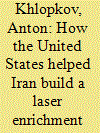

|
|
|
|
|
| Publication |
2013.
|
| Summary/Abstract |
In the spring of 1975, Iran became one of the first states to begin comprehensive research into using lasers for uranium isotope separation. As part of that research, the government sought the expertise of Jeff Eerkens, a leading American specialist in the field. This investigative article tells the story of their relationship: how it began, how it developed, and how it ended, drawing extensively from the authors' personal interviews with Eerkens as well as numerous publications and other interviews.
|
|
|
|
|
|
|
|
|
|
|
|
|
|
|
|
| 20 |
ID:
183126
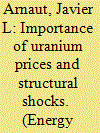

|
|
|
|
|
| Summary/Abstract |
Over the past decade, Greenland has lifted and restored its ban on uranium mining amid the uncertainty of global uranium prices. This article investigates the dynamic interrelations between uranium commodity prices and the impacts of structural shocks, sketching key economic implications for Greenland. Using a structural vector autoregressive model, this work analyses the changing relations between uranium prices, coal prices as well as real and financial variables from 1980 to 2019. The main findings are that the dynamics of uranium spot prices are diversely affected by shocks in combined real GDP, total electricity production from nuclear power, the interest rate, the real effective exchange rate, and the price of coal. The estimates also show that the pricing dynamics are important for future production and capital investment decisions. The analysis illustrates that despite the prevailing depressed uranium market, Greenland can still capitalize on future market developments. The country can anticipate benefiting from a short-run world supply disruption, a positive combination of macroeconomic shocks, and the long-term expansion of nuclear energy programs.
|
|
|
|
|
|
|
|
|
|
|
|
|
|
|
|
|
|
|
|
|